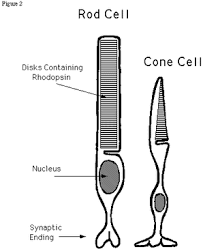

Rod cells, or rods, are photoreceptor cells in the retina of the eye that can function in less intense light than can the other type of visual photoreceptor, cone cells. Named for their cylindrical shape, rods are concentrated at the outer edges of the retina and are used inperipheral vision. On average, there are approximately 90 million rod cells in the human retina.[1] More sensitive than cone cells, rod cells are almost entirely responsible for night vision
Cone cells, or cones, are photoreceptor cells in the retina of the eye that are responsible forcolor vision; they function best in relatively bright light, as opposed to rod cells that work better in dim light. Cone cells are densely packed in the fovea, but gradually become sparser towards the periphery of the retina.
A commonly cited figure of six million in the human eye was found by Osterberg in 1935.[1]Oyster's textbook (1999)[2] cites work by Curcio et al. (1990) indicating an average close to 4.5 million cone cells and 90 million rod cells in the human retina.[3]
Cones are less sensitive to light than the rod cells in the retina (which support vision at low light levels), but allow the perception of colour. They are also able to perceive finer detail and more rapid changes in images, because their response times to stimuli are faster than those of rods.[4] Because humans usually have three kinds of cones with different photopsins, which have different response curves and thus respond to variation in colour in different ways, we have trichromatic vision. Being colour blind can change this, and there have been reports of people with four or more types of cones, giving them tetrachromatic vision.[5][6][7] Destruction to the cone cells from disease would result in blindness. A study involving mice injected with opsin into their retinas showed retinal activity involving light signals three months late.



